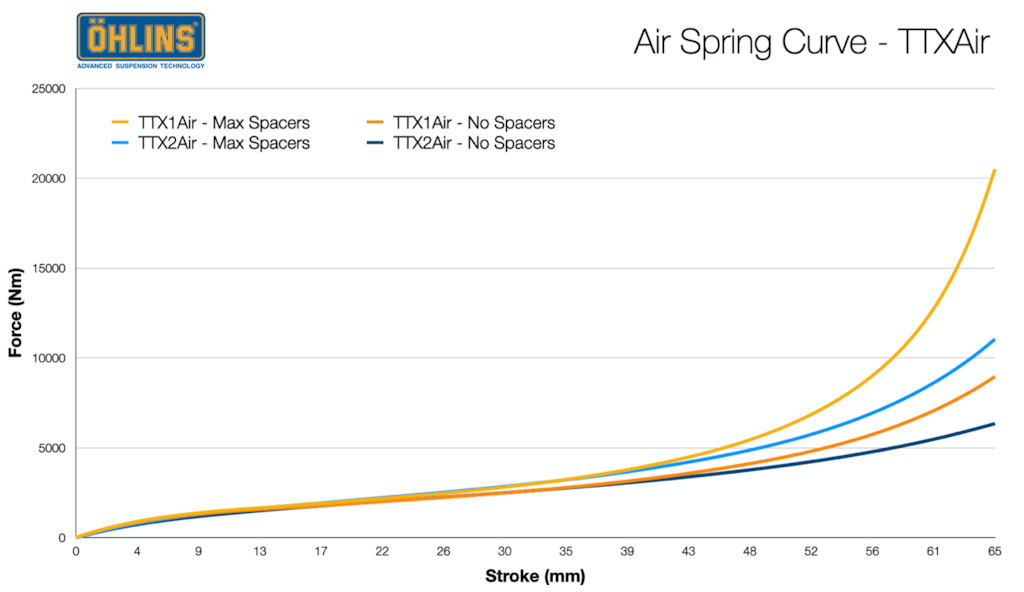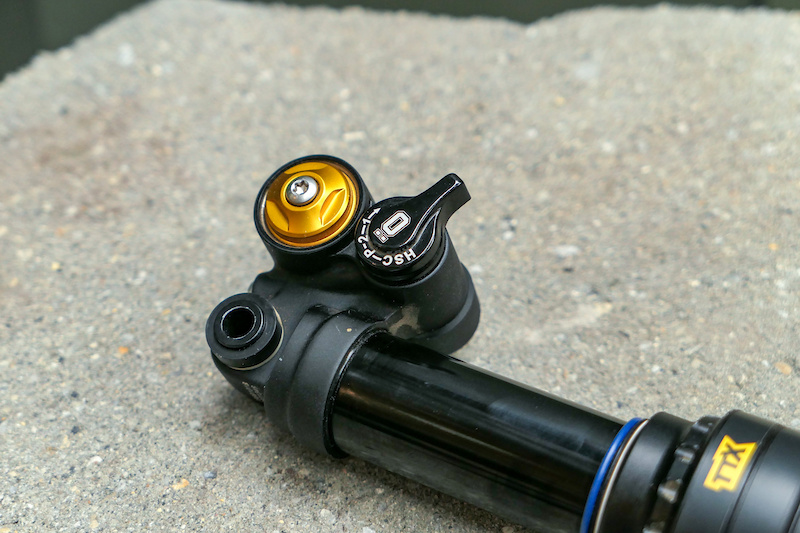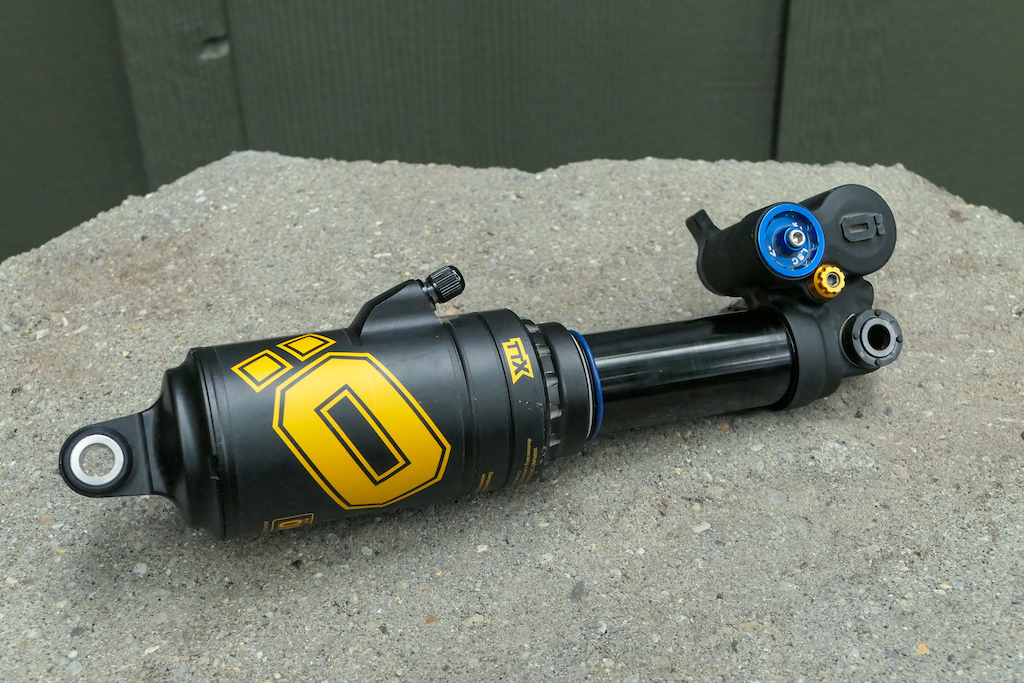Review: Ohlins TTX Air - Shock Week 2023
Ohlins TTX Air 2
Identifiable by its Swedish gold, or yellow - whatever it is, Ohlins shocks are recognizable and well respected with a rich heritage in motor vehicle racing. When they first entered the mountain bike market, only coil shocks were produced. Demand for an air shock was met shortly after that focused on trail and enduro bike applications.
The TTX Air follows suit with the rest of Ohlins mountain bike shocks, which use a twin tube damping architecture to separate the oil flow into two directions, compression and rebound.
The TTX Air follows suit with the rest of Ohlins mountain bike shocks, which use a twin tube damping architecture to separate the oil flow into two directions, compression and rebound.
TTX Air 2 Details
• 2 air can sizes available
• 3-position HSC lever
• High-speed compression - 3 clicks
• Low-speed compression - 11 clicks
• Rebound - 12 clicks
• Weight: 519 grams
• Price: $780 USD
• ohlins.com
• 2 air can sizes available
• 3-position HSC lever
• High-speed compression - 3 clicks
• Low-speed compression - 11 clicks
• Rebound - 12 clicks
• Weight: 519 grams
• Price: $780 USD
• ohlins.com
This isn’t the first time we’ve covered the TTX Air 2 - Seb Stott published a detailed review and chat with Ohlins back in March, 2022. This time around, we’ve put it head-to-head against four other air shocks, all of which were mounted to the same bike, and scrutinized under multiple tech editors.
Setup
In order to deal with the variability of leverage curves amongst the bikes on the market, two air can sizes are available in the TTX, denoted by the number “1” and “2” in the shocks' nomenclature. Ohlins prescribed the TTX Air 2 with a lighter damping tune that was developed by their enduro racers. The TTX Air 2 features a larger positive and negative air volume, giving less progression than the TTX Air 1 for our Santa Cruz Nomad test sled.
Ohlins has a comprehensive Performance Suspension Guide and a bank of tunes available for popular bikes on the market, however, the online calculator might need to be updated since the Nomad V6 was not listed.
It’s worth pointing out that only the TTX Air shocks are not available in the common downhill bike length. Only the coil TTX models are produced in lengths greater than 230x65 or 205x65mm.
Ohlins says that this shock was designed around bikes that are meant to climb to the top of descents. Packaging the TTX Air into longer lengths would require a redesign
Installing the TTX Air 2 on the Nomad is a tight squeeze as the position of the air valve rides very close to the top of the shock tunnel, but there is sufficient clearance. Checking the sag, which was set to 30% (180 psi @ 78kg rider weight), is less taxing for this combination as the body is not impeded by the frame, like the DVO or Marzocchi.
Similarly, all of the damper adjustments are very accessible too, mind you, the rebound and LSC will require a 3mm allen key to turn. Those damper adjustments were turned 7 clicks from closed on the LSC, 5 or 6 out on the rebound dial, and the HSC lever was left in the fully open position for descending.

Ohlins prescribed the less progressive TTX Air 2 with larger positive and negative air chambers for the Santa Cruz Nomad V6.
Climbing
In the case of the TTX Air 2, there isn’t a “lockout” per se. Instead, a lever on the HSC offers three settings, in which the firmest position acts as a “climb mode”. Ohlins' theory on this is said to allow very low speed movements without totally blocking off all forces.
On the trail, that’s true too. Rather than turning into a solid brick, as the Vivid’s “Threshold” lever does, the TTX Air has a small amount of resistance that gives away when it encounters a bump. The shock remains firm enough to resist pushing deep into the travel yet doesn’t turn the bike into a hardtail either.
Reaching the lever is second nature due to its lateral axis and location on the forward mount. Unlike the Float X2 or Bomber Air, this switch has clicks that you know when you have moved out of the closed position.

0% Loaded
1/5
Turning the lever clockwise closes off the bleed port, restricting the flow, and forcing the oil through the smallest port and into the shim stack.
Descending
Each suspension brand sent over their optimized shock for the Santa Cruz Nomad and Ohlins provided us with one of the lighter damping tunes that was developed in conjunction with their enduro athletes.
That was surprising to hear because the TTX Air required the most attention to ride. Control of the bike was high - in that the rear wheel tracked the ground impressively - but more effort was needed to work the bike through choppy root sections.
I experimented further with the TTX Air to try and recoup some comfort when I wasn’t totally engaged on the bike. Lowering the pressure by 3 psi helped to relax the shock just enough to bring back some cushion. In doing so, I began to reach the bottom of the travel on g-outs, such as abrupt rock rolls, that weren’t previously an issue. Adding a volume spacer didn’t win me over though, as the ramp up brought on too much force. I’d rather occasionally use up all 65mm of shock travel than hitting the progression ramp of decreased air volume frequently and so I reverted to the original setup.
This is where the extra feature, and weight, of the hydraulic bottom out can be the right card to play. There’s no doubt that Ohlins has developed a superb air shock, but for the price, you can find more adjustments on the RockShox Vivid.
Pros
+ Racer-like control
+ Two air can sizes available to suit different leverage curves
+ HSC lever offers a special blend of support and traction to climbing
Cons
- 3mm allen key required to adjust LSC and rebound - arguably the ones most frequently changed
- Required the most time to settle on a sweet spot
- Higher cost with less adjustments than Fox and RockShox options
Author Info:
Must Read This Week
Sign Up for the Pinkbike Newsletter - All the Biggest, Most Interesting Stories in your Inbox
PB Newsletter Signup






From my experience, it is the only one that takes into account the progression curve at all, let alone specific to bike models. This means it corrects for sag at the shock vs the wheel (30% at wheel will be less than 30% at shock with any progression), and it corrects for leverage ratio at your sag point (spring rate will need to be higher than average with any progression). Every other calculator I've used (TFTuned, EXT, Fox, SRAM...) underestimates spring rate pretty drastically.
Which one is recommended, and which one do manufacturers use when displaying their leverage curves with the sag point?
dirtbikemagazine.com/race-sag-set-up-mr-know-it-all
Pretty sure all piggybacks, all shocks really, have oil flowing in 2 directions. The real benefit of twin-tubes is that all the oil has a chance to go through the the base valves, not just the oil displaced by the shaft. The shaft-displaced oil always ends up in the piggyback, but without twin-tubes allowing recirculation of oil to "behind" the piston, all other oil must flow through the valves on the piston. This limited flow of oil through the base valves means those valves have less influence on the damping on a monotube setup, quin, compared to a twin-tube's recirculating setup.
Also pretty amazing that 3 psi made such a difference, despite all these set ups somehow always hitting nice round numbers for pressure and sag: exactly 180 psi for exactly 30% (19.5mm), not 183psi, not 178psi, not 19mm (29.2%), not 21mm (31.3%). The Bomber at exactly 200 and DVO at exactly 190 and 160... No one else bracketed 3 psi changes?
If you’re gonna talk about Fox knobs, you should suggest they relabel the rebound on the DPX2 as lsc. So maybe having “less adjustments” that actually function correctly isn’t a con at all?
Dpx2 PB’s review: m.pinkbike.com/news/fox-float-dpx2-shock-first-look-2017.html
See first paragraph, the word “independent” is already there.
Singlerack doesn't know how to properly instal a coil spring for their review. Look at the pics carefully: www.singletracks.com/mtb-gear/first-impressions-marzocchi-bomber-cr-coil-shock
Don't expect much from text editors...
Well, what I initially meant to say is that reviewers do influence buyers, particularly those without much hands on experience or ability to test several parts. And some of the pros and cons written lately seem to me more influenced by who’s sponsoring PB than by the actual product itself, some are just flat out shameful. It’s a disservice for those potential buyers looking for honest opinions. That’s all.
For specifics - on my Spec Enduro at 73kg loaded rider and target 30% sag at wheel, every other calculator gives me 400-425# rec, and Ohlins' calc gives me 500# which is definitely closer to my needs. It's a significant difference and saves a fair bit of pain for folks not just spending money on springs, but time.
Also, I just checked my math and I was wrong... I'm 80kg loaded up. So sounds about right that I'm +25# from you.
Ive got this on my Mondraker Foxy, and at 190lbs, I run the biggest spacer there is, and it adds just that wee bit of support to the last 10% of travel. Initially, I was bottoming constantly, even at 20% sag.
this shock really is spectacular at consistantly and predictably tracing the ground and never being overwhelmed. Once it's dialed, it just gets to work. Also, at this point, it's very very proven....unlike it's competitors from RS and Fox.
The DPX2 only just contacts the frame due to the reservoir, so is a no go. Wondered if this fit and was a step up in performance?
takes 30 min
doesn't strike me as more or less than a high end RS or Fox shock
Thats wonderful to hear about that shock, i'm really considering an EXT they look amazing to!
Why is this called a theory? It does exactly what is says it does. Obviously it's adjusting preload on the high-speed shim stack, forcing flow primarily through the low-speed port while still letting the HS valve to open (blow-off) when needed for big hits. Just like pretty much every climb switch. (Except CaneCreek, which slows down both low-speed circuits to really control bob the right way, since body-weight movements are primarily low-shaft-speed events.)
speak for yourself!
At least the Ohlins gives you the ability to really dial in, unlike the Bomber where you can't even set some things, so it's just the forget part. Though in the Bomber review they mentioned having to remember settings, so who the hell knows what they even mean by set or forget.
I can totally understand this, whereas suspension settings and preference in my experience can vary quite a bit, depending on many things and become frustrating when all we wanna do is ride and have fun doing it, not being bogged down in frustration, unsure if its set up optimally to render the full benefits of all the settings available.
But it's ok if you're frustrated at suboptimal set up because it just doesn't have the settings available?
Im personally more frustrated with whether or not i should have 1psi more or less, depending on where i'm riding that day, how hot / cold it is or if i'm going to wear a pack and how much crap i'll put in it; than i am about if i just had independent high speed- rebound / compression.
That's not about you? Lot of "I"s for 3rd person.
then you understand why 67v70psi is noticeable and 190v187 is not. lol
There're a lot of tests and articles of theirs products which are eulogistic when a lot of users are complaining about their performance. A few people during bike park sessions told me that they had struggle to adjust properly their suspension.
I tried too and i lend my bike to a few friends to have theirs thoughts and they were unanimous, it's not rideable as it is. So i finally sent my RXF36 Air and my TTX2 to a Professional tuning. They confirmed me that it's necessary to remove the famous "grey spacer" from the fork to improve the sensitivity, wich is quite strange for an high range suspension. They also made a proper tuning to decrease the HSC damping and the sensitivity of the TTX.
But the results are not turning out as i expected. It's better for the fork but there 're still to much damping in the HSC, a too significant rebound even full closed, wich result to a pain in my palms that i never had before, even with a cheap fork. Like if it's locked on HSC. I have a similar problem with the TTX. A weak sensitivity on small bumps and a harsh feeling on HSC.
I finally switched for a 38 grip2 and a DHX2 and it's like night and day.
There're also good feedbacks of theirs products so i wonder if it's not a question of damping tunes wich are not suitable for all frames. Or maybe some compagnies ask for a specific tune for theirs bikes.
@ohlins terrible after sales support!!
To me its actually is all to the rider ... I constantly see clowns with 13,000 bikes who cant ride for shit and others with old 1200 usd bikes who rip through trails.